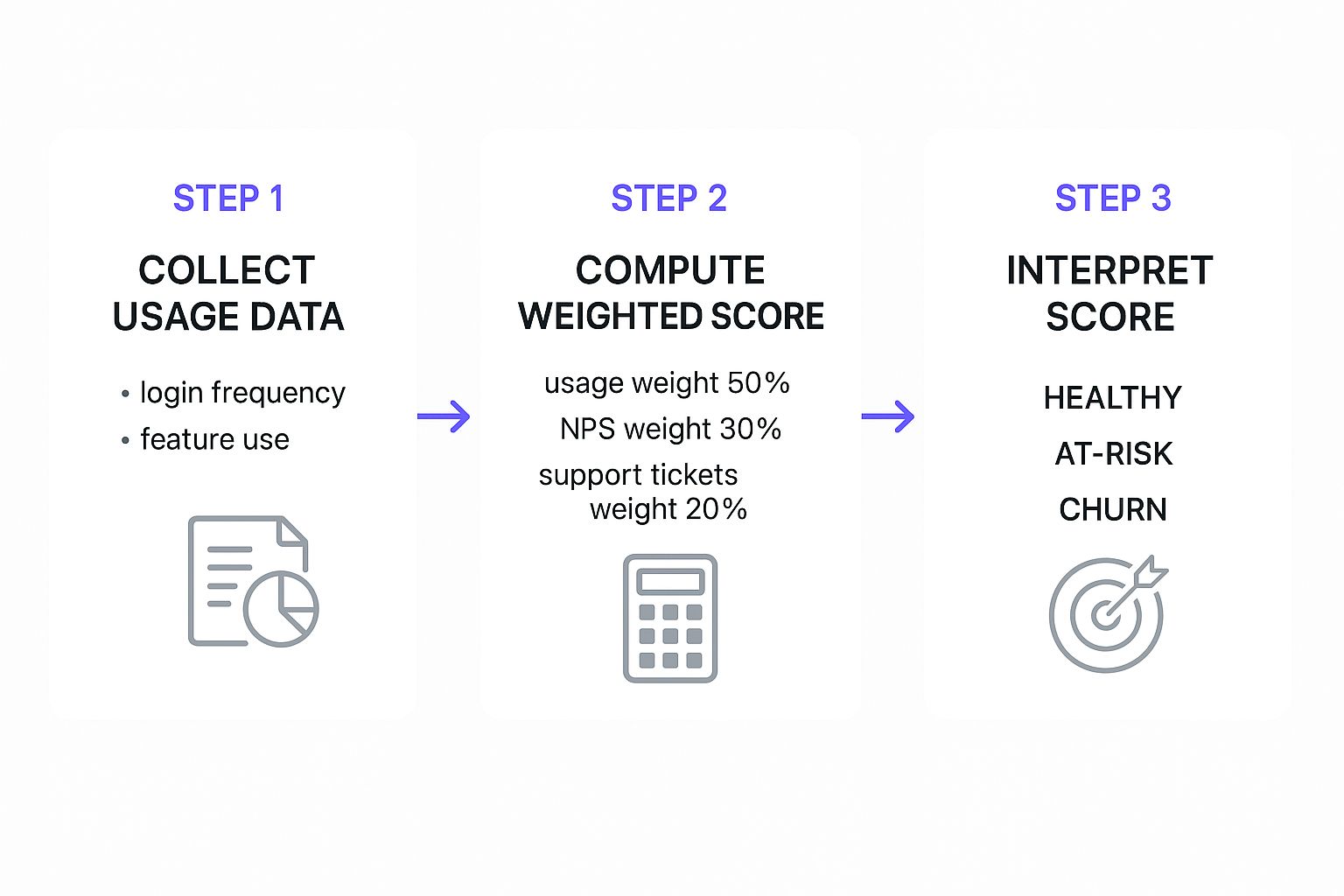
See the October 17th Webinar Summary
Here



Imagine you had a crystal ball that could tell you which of your customers are happy and which are quietly packing their bags. That's essentially what a well-crafted customer health score gives you. It's an early warning system that shifts your entire approach from reactive firefighting to proactive relationship building.

Think of a customer health score like a vital sign monitor for your client relationships. It boils down complex behaviors into a single, straightforward metric that tells you how engaged a customer is, how satisfied they are, and ultimately, how likely they are to stick with you.
Flying blind by relying on gut feelings or isolated interactions is a dangerous game. Without a complete picture, you might think a customer who always pays on time is in great shape, completely missing that they haven't logged into your platform in 90 days. On the flip side, you might mistake a customer who contacts support often as a problem account, when in reality, they could be one of your biggest fans, pushing your product to its limits. A health score cuts through that ambiguity.
The idea of scoring customer health isn't brand new. It first emerged in the early 2010s as a way for Customer Success Managers to make sense of their data. But those early models were often clunky and hamstrung by siloed information. It wasn't uncommon for a "healthy" customer to churn out of the blue, simply because the score was missing key pieces of the puzzle. This history really underscores why the sophisticated, real-time analytics we have today are so crucial.
A customer health score transforms your team from firefighters, constantly putting out customer fires, into architects, proactively building stronger, more resilient customer relationships.
A solid scoring system gives you the hard data you need to spot trouble on the horizon. It's the difference between getting that dreaded "we're canceling" email and seeing a warning flag six weeks earlier when you still have time to turn things around. That proactive mindset is the cornerstone of sustainable growth.
When you can pinpoint at-risk accounts, you can deploy targeted interventions to get them back on track. For a broader look at this, check out these strategies to reduce churn rate. But it's not just about preventing churn. These scores also shine a spotlight on your happiest, most successful customers—the ideal candidates for upsell opportunities, case studies, and powerful referrals. This two-sided benefit makes the customer health score one of the most essential tools in your entire retention playbook.

A truly effective customer health score isn't just one number; it’s a composite story told through different data points. To get an accurate reading, you have to look beyond a single metric and assemble a holistic view of the customer relationship. This means pulling together data from multiple sources to create the full picture.
Think of it like building with LEGOs. A single brick doesn’t tell you much, but when you combine them, you can build something detailed and meaningful. The four core "bricks" of your customer health score are product engagement, support history, financial health, and direct feedback. As you define the metrics for these blocks, it's wise to consider broader principles on how to measure operational efficiency effectively to make sure your indicators truly matter.
Here's a breakdown of the key metrics that form the foundation of a robust customer health score. Each category provides a different lens through which to view the customer relationship, and together, they paint a comprehensive picture.
Metric CategoryExample MetricsWhat It IndicatesProduct EngagementLogin Frequency, Key Feature Adoption, Session Duration, Breadth of UseHow deeply and frequently customers are using your product. High engagement often correlates with high value and retention.Support HistoryTicket Volume, Ticket Severity, Time to ResolutionThe customer's experience with problem-solving. It can highlight friction points or, conversely, successful, engaged learning.Financial HealthPayment Timeliness, Subscription Tier, Renewal History, Upsell/Cross-sell HistoryThe commercial strength and commitment of the relationship. It's a direct measure of the value they place on your service.Customer FeedbackNet Promoter Score (NPS), Customer Satisfaction (CSAT), Survey ResponsesThe customer's stated feelings and sentiment. It provides crucial context that behavioral data alone can't capture.
By weaving these different data points together, you create a score that is not only accurate but also actionable, giving your team the insights they need to intervene effectively. Let's dig into each of these categories.
This is arguably the most crucial pillar. It measures how deeply and how often customers use your product, which is often the strongest predictor of whether they'll stick around. An active user is a user who sees value.
Keep an eye on metrics like:
Your support desk is an absolute goldmine of information about customer health. The nature and frequency of their interactions can reveal everything from frustration and confusion to deep engagement and a desire to master your product.
A customer submitting a lot of support tickets isn’t automatically unhealthy. A new user asking tons of questions might be highly engaged. On the other hand, a long-time user suddenly reporting critical bugs could be a major churn risk. Context is everything.
Consider these support indicators:
This category gives you a clear, quantitative look at the business relationship. It's the "show me the money" component of your health score, directly reflecting a customer's commitment and the value they believe they're getting.
But financial health is more than just whether they pay on time. It also includes:
Finally, you need to listen to what your customers are telling you. While their behavior (what they do) is critical, their sentiment (what they say) fills in the gaps and provides priceless context.
This feedback can come from several sources:
By combining these four building blocks, you move from a flat, one-dimensional number to a multi-faceted, accurate, and truly predictive customer health score.
Alright, let's move from theory to practice. A customer health score is just an abstract idea until you actually calculate one. The good news is that you don't need a data science degree to get started. By following a clear, logical process, you can create a working score that gives you real-time insight into your customer relationships.
First things first: you need to gather your data. Right now, your customer information is probably scattered across different systems. You’ve got contract details in your CRM, usage stats in your product analytics tool, and support tickets piling up in your helpdesk. The initial step is to pull all that information into one place. This could be a straightforward spreadsheet to begin with, or a more sophisticated platform like Statisfy.
Let's walk through a simple, real-world example. Imagine we run a SaaS company and, after looking at our data, we've figured out that three key metrics are strong predictors of whether a customer will stick around: product usage, their latest NPS rating, and how many support tickets they've submitted.
Of course, not all of these metrics carry the same weight. We need to decide which ones are most important.
For our fictional company, we've landed on this breakdown:
Next, we have to standardize these different metrics. We'll convert everything to a simple 0-100 scale, where 100 is a perfect score. Let's take one of our customers, "Innovate Corp," and see how they stack up:
Now for the final calculation. We just apply our weights to each score:
(75 × 0.50) + (100 × 0.30) + (90 × 0.20) = 37.5 + 30 + 18 = 85.5
Just like that, we've combined several different data points into a single, meaningful number.

This workflow, from gathering raw data to assigning a final health status, is the core of the entire process.
So, Innovate Corp has a score of 85.5. What does that actually mean? The final piece of the puzzle is setting clear thresholds that sort your customers into different buckets. Every business will have slightly different ranges, but the principle is the same.
A customer health score isn't just a number; it's a trigger for action. Defining what 'good,' 'at-risk,' and 'poor' look like is what turns data into a proactive strategy.
A simple traffic light system works wonders here:
This framework gives your team a clear playbook. Whether you start this journey with a basic spreadsheet or jump straight to an AI platform, this method provides a direct path to understanding—and improving—the health of your entire customer base.

A customer health score is just a number. It's interesting, but it doesn't do anything on its own. The real magic happens when you connect that score to a specific plan of action.
This is where playbooks come in. By pairing each health category—good, at-risk, and poor—with a pre-defined playbook, you turn passive data into an active strategy. It's the difference between knowing the score of a game and having a coach on the sidelines calling the next play. For more general tips on playbook creation, you can explore these strategies for building playbooks.
These playbooks give your team a clear, consistent response for every situation, removing the guesswork so they can act with confidence.
When a customer's score plummets into the "Red" zone (usually below 50), alarms should be going off. This is an all-hands-on-deck moment that calls for immediate, personal intervention to figure out what went wrong.
Your playbook for these accounts needs to be swift and hands-on:
Customers hovering in the "Yellow" or "At-Risk" category are often your most critical focus group. They haven't given up, but they're showing clear warning signs, like dipping product usage or a less-than-enthusiastic NPS score. This is where you can make the biggest impact.
This is your chance to be proactive. These customers aren't lost causes; they're opportunities to reinforce value and re-engage them before minor issues become major problems.
The playbook for your "Yellow" accounts should be all about education and gentle re-engagement:
It’s easy to focus on fires and forget your happiest clients, but your "Green" or "Healthy" accounts are your biggest assets. The playbook here isn't about saving them; it's about nurturing them into advocates and spotting growth opportunities.
For these champions, your playbook should focus on appreciation and expansion:
Getting your customer health score model up and running is a huge accomplishment, but don't pop the champagne just yet. This is where the real work begins. Think of it less like launching a rocket and more like planting a garden; it needs constant attention to flourish.
The best scoring systems are dynamic, not static. They have to change right along with your product and your customers. Your initial weights for different metrics are really just your best-educated guesses. Over time, as you roll out new features or refine who your ideal customer is, the very definition of a "healthy" customer will shift. An action that was a key indicator of success last year might be table stakes today. That’s why consistent iteration isn't just a good idea—it's essential for the score to remain accurate.
A health score that your teams don't believe in is worse than useless; it's just noise. For this metric to become a cornerstone of your strategy, you need to build trust and get buy-in across the entire company.
The ultimate goal is to make the customer health score a shared language. When everyone from Sales to Support understands what a score means and trusts the data behind it, it stops being just a Customer Success metric. It becomes a central part of how a truly customer-focused company operates.
This need for continuous improvement isn't just a theory; it's a major trend across the industry. The way we measure customer health is getting more and more sophisticated, driven by massive datasets and collaborative expertise.
For example, one leading 2025 customer health score template was developed with input from over 250 industry professionals and incorporates more than 550 distinct suggestions for improvement. This model was fine-tuned using data from over 10 million interactions and insights from more than 80 top-tier companies, including giants like Apple and Google. This shows a massive, collective push toward truly data-driven retention. You can learn more about these advanced scoring methodologies and see how they’re being used to get ahead of churn.
This dedication to refinement is what keeps a scoring system from going stale. By regularly re-evaluating your metrics, tweaking weights based on real-world churn and renewal data, and listening to feedback from your customer-facing teams, you ensure your customer health score stays sharp. This ongoing work is what turns a simple number into a powerful strategic asset that drives smarter decisions and fuels long-term growth.
As you start piecing together your own customer health scoring system, you're bound to run into some common questions. We hear them all the time from teams just getting started. Getting these sorted out early on can save you a world of headaches and help you build a system that actually works.
Let's dive into the most frequent ones.
There's no magic number here—it really boils down to your business and how your customers interact with you. The goal is to have data that's fresh enough for your team to act on before it's too late.
For a high-touch enterprise software company, where big strategic shifts might happen quarterly, updating scores once a week could be perfectly fine. But if you're a high-volume SaaS business with users logging in every day, you need something closer to real-time. If you wait a week to find out a key user has gone silent, you've likely already missed the window to re-engage them.
Pro Tip: When in doubt, start with weekly updates. It’s a solid baseline. You can always dial up the frequency as you get more comfortable and see what your team can realistically handle. The key is to match your data's rhythm to your customer's rhythm.
By far, the most common trap is the "set it and forget it" mindset. I've seen countless companies spend months crafting what they think is the perfect, all-encompassing scoring model, only to launch it and never look at it again. That's a surefire way to make your health score completely irrelevant.
Your business changes. Your product gets new features. Your customers' needs evolve. Your health score has to keep up.
Instead of trying to build a masterpiece from day one, start simple. Pick 3-5 core metrics that you know are solid indicators of success or churn—things like key feature adoption or how often someone logs in. Get that version running, then commit to reviewing and tweaking it regularly. An iterative, flexible approach is what keeps your score sharp and genuinely useful.
This is a fantastic and important question. They both tell you something about your customer, but they measure two very different things. Think of it like this:
You really need both for the full picture. A customer might love your brand and give you a glowing NPS of 9, but if they haven't logged into your product in two months, they're a huge churn risk. They like you, but they aren't getting value. Combining sentiment with behavior reveals these hidden risks.
Absolutely! You don't need a huge data science team or a six-figure budget to make this work. In fact, getting a simple health score in place early is one of the smartest things a small business or startup can do.
You can start with something as straightforward as a well-organized spreadsheet. Pull in data from your payment system like Stripe and whatever product usage data you can access. The core principles are the same no matter your size.
Just figure out what a "healthy" customer looks like for you, track those behaviors consistently, and set simple rules for when and how to act. Building this muscle early creates a customer-focused foundation that will pay dividends as you grow.
Ready to move beyond spreadsheets and guesswork? Statisfy’s AI-driven platform automates the entire process, turning your raw customer data into clear, actionable health scores and proactive recommendations. Book a demo today to see how you can predict churn and drive retention effortlessly.